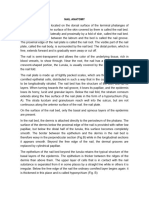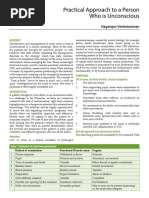henderson1984
Uploaded by
dr.mvillasanahenderson1984
Uploaded by
dr.mvillasanaThe Best Dressing For A Nail Bed Is The Nail Itself
H. P. HENDERSON
From the Leicester Royal Infirmary
The replacement of a surgically avuised nail as a splint and dressing with "Superglue" is
reported. It provides a painless cover for the sterile matrix and facilitates the dressing of finger
tip injuries.
In the past decade Plastic Surgeons have begun to use
cyanoacrylate glues for the attachment of skin grafts to
the margins of the recipient site and the fixation of
rubber bands to the nails of fingers requiring dynamic
traction following tendon repair. This "Superglue" can
also be used for fixing the fingernail over the sterile
matrix as a temporary and pain free dressing after nail
bed surgery. A small quantity of "Superglue" is placed
in the lateral nail bed gutter, which will fix the nail for
four to five days securely. During this time the nail bed
will heal spontaneously beneath the nail, which then
separates painlessly and can be discarded.
Case Report
A fifty year old healthy Caucasian lady presented with
distortion of the nail of the middle finger of one hand.
A bluish discolouration was noted through the buckled
nail at the level of the lunula and beneath the nail fold Figs. l - 3 T h r e e views o f t h e n a i l , with d i s t o r t i o n at t h e level o f t h e
close to the germinal matrix (Figs. 1-3). Under a digital lunula.
block with tourniquet, a proximally based skin flap was
raised off the base of the nail. The whole nail was
removed intact. A cyst was seen under the nail bed and a Subsequent follow-up showed that the nail had begun to
transverse incision was made across the central dome of re-grow normally and the appearance at two months is
it at the level of the base of the nail (Fig. 4). The cyst shown in Fig. 8. A completely normal nail was seen four
was removed intact, leaving a large cavity (Fig. 5). It months post-operatively (Fig. 9).
was thought that the germinal matrix may have been
damaged or distorted by the cyst or its surgical removal
and the incision line was repaired with a 6/0 prolene
suture, woven in a subcuticular fashion from one side of
the finger to the other (Fig. 6). The skin flap was re-
sutured in place, but the nail bed still presented a
slightly uneven surface and it was felt that the best
dressing would be the nail itself. The nail had become
Discussion
buckled by the cyst, as shown in Figs. 2 and 3, and by
scoring the under surface it was possible to flatten it so Replacing the nail as a splint and dressing in finger tip
that it would adapt to the flattened nail bed. The nail injuries was first brought to my attention by Dr. Guy
was then trimmed at its margins and its proximal part Foucher in Strasbourg, and I have found this a very
slipped beneath the edge of the skin flap. Some useful technique on several occasions since then. The
"Superglue" was then applied around the margin of the nail can be difficult to pass stitches through and for this
nail, thereby fixing it in place without the use of any reason is seldom used as a dressing in the treatment of
stitches (Fig. 7). The patient returned one week later and nail bed injuries or lacerated nails. I believe, however,
reported the nail had loosened that day. The prolene that the nail should be retained whenever possible
suture was removed. The nail bed had healed well and because it can be used as a splint and simultaneous
the patient commented that she had suffered practically waterproof dressing in many finger tip injuries, and in
no pain at all. A simple Bandaid dressing had been many cases eliminates most of the pain attributable to
applied to the finger tip at the time of the operation and exposure of the nail bed. A few drops of "Superglue"
this had been changed only once, and without difficulty. around the margin of the nail is sufficient to keep it in
place for long enough to provide time for adequate
Received for publication October, 1983.
H. P. Henderson, F.R.C.S., Leicester Royal Infirmary, Leicester LEI 5WW. healing of the underlying tissues.
VOL. 9-B No. 2 JUNE 1984 197
H.P. HENDERSON
Fig. 4 Transverse incision in the nail bed. Fig. 5 Cyst removed intact. Fig. 6 Subcuticular type suture across defect.
Fig. 7 Nail replaced and fixed with Superglue. Fig. 8 Nail after two months. Fig. 9 Nail after four months.
198 THE JOURNAL OF HAND SURGERY
You might also like
- Test Bank For Understanding Anatomy and Physiology 2nd Edition by Thompson100% (43)Test Bank For Understanding Anatomy and Physiology 2nd Edition by Thompson7 pages
- The Mozena Classification System and Treatment Algorithm For Ingrown Hallux NailsNo ratings yetThe Mozena Classification System and Treatment Algorithm For Ingrown Hallux Nails5 pages
- Surgical Treatment of Acute Fingernail Injuries 2012No ratings yetSurgical Treatment of Acute Fingernail Injuries 20126 pages
- Nailbedinjuries 150719025153 Lva1 App6892No ratings yetNailbedinjuries 150719025153 Lva1 App689232 pages
- Manejo de Lesiones de Punta Digital en Escocia y Reino UnidoNo ratings yetManejo de Lesiones de Punta Digital en Escocia y Reino Unido3 pages
- SBFS Small Bone Fixation System Surgical TechniqueNo ratings yetSBFS Small Bone Fixation System Surgical Technique8 pages
- A Comprehensive Review On Human Nail: International Journal of Medical and Health ResearchNo ratings yetA Comprehensive Review On Human Nail: International Journal of Medical and Health Research3 pages
- Reilly Toenailsurgery IndicationsoptionsandtechniquesNo ratings yetReilly Toenailsurgery Indicationsoptionsandtechniques8 pages
- Reilly.Toenailsurgery.IndicationsoptionsandtechniquesNo ratings yetReilly.Toenailsurgery.Indicationsoptionsandtechniques9 pages
- Skin Infection Around A Fingernail or Toenail (Paronychia)No ratings yetSkin Infection Around A Fingernail or Toenail (Paronychia)3 pages
- Partial Nail Avulsion and Matricectomy For Ingrown ToenailsNo ratings yetPartial Nail Avulsion and Matricectomy For Ingrown Toenails5 pages
- Soft-Tissue Nail-Fold Excision: A Definitive Treatment For Ingrown ToenailsNo ratings yetSoft-Tissue Nail-Fold Excision: A Definitive Treatment For Ingrown Toenails5 pages
- Common Lesser Toe Problems - Surgical Options: Claw, Hammer and Mallet ToesNo ratings yetCommon Lesser Toe Problems - Surgical Options: Claw, Hammer and Mallet Toes2 pages
- Hook Nail Deformity Surgical Treatment With A Homodigital Advancement Flap 1995 The Journal of Hand Surgery British European VolumeNo ratings yetHook Nail Deformity Surgical Treatment With A Homodigital Advancement Flap 1995 The Journal of Hand Surgery British European Volume6 pages
- 51.umesh C. Suryawanshi Snehal S. Patil Nikita S. Patil Rohan R. Vakhariya C. S. MagdumNo ratings yet51.umesh C. Suryawanshi Snehal S. Patil Nikita S. Patil Rohan R. Vakhariya C. S. Magdum12 pages
- Ingrown Toenail: A Small Nail Causing A Big Pain: Healthy ToenailsNo ratings yetIngrown Toenail: A Small Nail Causing A Big Pain: Healthy Toenails4 pages
- 2006, Vol.24, Issues 3, Nail Disorders and Their ManagementNo ratings yet2006, Vol.24, Issues 3, Nail Disorders and Their Management105 pages
- LEARNING ACTIVITY SHEET IN NAIL CARE SERVICESNo ratings yetLEARNING ACTIVITY SHEET IN NAIL CARE SERVICES15 pages
- Intro To Podiatry Week 7 - Part 2 Nail Pathologies - Student VersionNo ratings yetIntro To Podiatry Week 7 - Part 2 Nail Pathologies - Student Version52 pages
- Fingertip Injuries: Singapore Medical Journal January 2010No ratings yetFingertip Injuries: Singapore Medical Journal January 201011 pages
- CORE PEH12 Q4 Mod5 W1-2 Gapuzan Vincer-1No ratings yetCORE PEH12 Q4 Mod5 W1-2 Gapuzan Vincer-117 pages
- Advantage: Owner'S Manual Installation, Operation & PartsNo ratings yetAdvantage: Owner'S Manual Installation, Operation & Parts10 pages
- Centrifugation - Operating Manual - Centrifuge 5430 R PDFNo ratings yetCentrifugation - Operating Manual - Centrifuge 5430 R PDF92 pages
- Approach To Traumatic Orthopedic InjuriesNo ratings yetApproach To Traumatic Orthopedic Injuries2 pages
- EXPERT-JSA Plastering Works (Elevated Work) - 1No ratings yetEXPERT-JSA Plastering Works (Elevated Work) - 17 pages
- Practical Approach To A Person Who Is Unconscious: Nagarajan VenkataramanNo ratings yetPractical Approach To A Person Who Is Unconscious: Nagarajan Venkataraman5 pages
- PDF Crash Course Anatomy 4E 4th Edition Louise Stenhouse Download100% (7)PDF Crash Course Anatomy 4E 4th Edition Louise Stenhouse Download84 pages
- Worx WX240L 4V 3-Speed Cordless ScrewdriverNo ratings yetWorx WX240L 4V 3-Speed Cordless Screwdriver40 pages
- Physical Diagnosis of Pain An Atlas of Signs and Symptoms 3rd Edition CompressNo ratings yetPhysical Diagnosis of Pain An Atlas of Signs and Symptoms 3rd Edition Compress369 pages

























































































